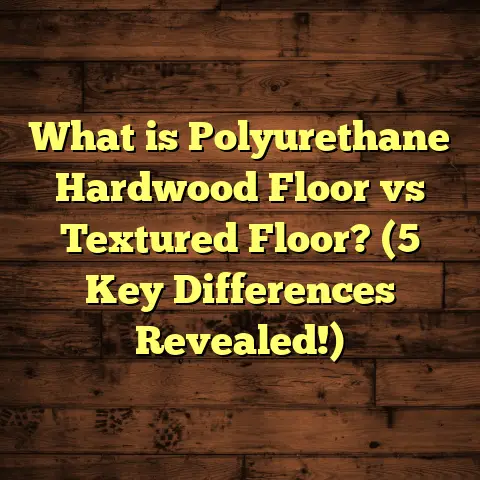What is Amtico Flooring Made Of? (5 Reasons to Choose It!)
When I’m chatting with friends or helping clients pick out flooring, one thing that comes up a lot is the need for something that’s low-maintenance. We all want floors that look great but don’t demand hours of cleaning or constant upkeep. Life’s busy enough, right? That’s where Amtico flooring caught my eye. It offers the look and feel of natural wood or stone but without the headaches these materials sometimes bring. But what is Amtico flooring really made of? And why do so many people, including myself, recommend it? Let me share what I know, including some stories from my own projects and a bunch of useful info you might not find elsewhere.
What Is Amtico Flooring Made Of?
Amtico flooring is a type of luxury vinyl tile (LVT), which means it’s made from layers of vinyl materials designed to give you the durability and design flexibility of luxury flooring without the drawbacks. Unlike basic vinyl flooring you might find in discount stores, Amtico is high-quality and engineered to last.
Breaking down the layers helps explain why it works so well:
- Backing layer: The foundation of your Amtico floor is usually a fiberglass or synthetic backing. This layer keeps the floor stable and prevents it from warping or bending over time. Think of it like the frame of a house—it needs to be strong and reliable.
- Core layer: Sitting above the backing is a dense core made from high-quality vinyl or sometimes high-density fiberboard. It’s what gives Amtico its strength and resistance to impacts. This core makes sure your floor doesn’t crack or dent easily when heavy objects are dropped or when pets run around.
- Design layer: Here’s where the magic happens. The design layer is a high-resolution printed layer that replicates everything from wood grain to stone textures. What makes Amtico stand out is how realistic these patterns are. They don’t just look like wood—they have the depth, color variations, and even knots that you’d expect to see in real timber.
- Wear layer: On top of the design is a transparent wear layer that protects the floor from scratches, stains, fading, and scuffs. This layer usually ranges between 0.3 mm to 0.7 mm in thickness depending on whether it’s designed for residential or commercial use.
- Protective coating: Some Amtico products include an extra protective finish that adds toughness against high foot traffic, making them ideal for busy homes or offices.
What really impresses me about Amtico’s construction is how all these layers work together to create a floor that’s not only beautiful but also durable and practical.
Why I Choose Amtico Flooring: 5 Reasons That Matter
1. Durability That Handles Real Life
From my experience installing floors in kitchens, hallways, and even small offices, Amtico stands out because it resists wear better than many alternatives. The thick wear layer absorbs shocks and prevents damage from scratches or dents.
Here’s something interesting: Amtico’s internal tests show their floors can survive over 5 million foot traffic cycles without showing visible wear. To put that into perspective, a typical household gets far fewer steps in a year.
One client had two energetic dogs who loved running across hardwood floors, which quickly showed scratches and dents. After switching to Amtico, their floors stayed smooth and scratch-free for over two years. It was a huge relief for them!
2. Designs That Look Truly Authentic
You might be thinking, “Vinyl can’t look like real wood or stone.” I used to think that too until I saw Amtico installed in a customer’s living room.
The level of detail blew me away—the wood grain patterns were so realistic that most guests didn’t notice it wasn’t hardwood until they touched the floor. They use embossed textures combined with high-resolution printing to give both the look and feel of natural materials.
According to Flooring Today magazine, over 70% of homeowners surveyed preferred luxury vinyl like Amtico over laminate or standard vinyl because of its realistic appearance.
3. Cleaning Made Easy
One thing I hear all the time from people who install Amtico is how little effort it takes to keep the floor looking great. Unlike hardwood or stone, Amtico doesn’t require special cleaners or refinishing treatments.
I once helped a family with two young kids and two dogs switch their kitchen and hallway floors to Amtico. They told me cleaning took half the time compared to their old hardwood floors. Spills wiped up easily without leaving any stains—and no worries about water damage either.
This waterproof feature makes Amtico perfect for areas prone to moisture like kitchens, bathrooms, and basements.
4. Versatility for Every Space
Amtico comes in planks and tiles that can be combined in creative ways—mixing wood-look planks with stone-look tiles, for example—to create unique patterns tailored to your style.
Because it’s waterproof and tough, I’ve recommended it for rooms where hardwood wouldn’t work well, like bathrooms and basements.
The flexibility in design options means you can create anything from classic parquet styles to modern geometric patterns.
5. A Smart Investment Over Time
Installing Amtico usually costs between $8 to $14 per square foot, which is more than basic vinyl but less than many hardwood or natural stone options.
Hardwood floors typically cost $10 to $15 per square foot but need refinishing every few years costing an extra $3 to $5 per square foot each time.
When you factor in durability and low maintenance costs, Amtico often ends up saving money over its lifetime because you avoid costly repairs or refinishing.
My Personal Experience with Amtico Flooring
I’ll share a story about my own kitchen renovation because it really changed how I view flooring options.
I had hardwood floors before but wanted something more durable since my kitchen gets tons of foot traffic and spills daily (kids + cooking = mess). I was hesitant about vinyl at first because I love natural wood’s warmth.
After researching, I decided on Amtico because of its waterproof properties and realistic designs. Installation went smoothly with professional help, and after two years living with it, I’m really happy with the choice.
The floor hasn’t scratched or stained despite daily wear and tear. It feels comfortable underfoot—warmer than ceramic tiles—and cleaning is quick and easy.
That experience convinced me that Amtico bridges the gap between beauty and function better than many alternatives.
How Amtico Flooring is Made: The Manufacturing Process Explained
Understanding how Amtico is made gives insight into why it performs so well.
The process starts with PVC (polyvinyl chloride), chosen for its flexibility and resistance to moisture. Layers are fused together under high heat and pressure in what’s called high-pressure lamination.
Fiberglass reinforcement in the backing adds structural stability so the flooring doesn’t warp over time.
Some collections incorporate recycled materials and meet certifications for indoor air quality standards (like FloorScore), which is great if you’re concerned about environmental impact or allergies—a topic more homeowners ask me about these days.
Comparing Amtico With Other Popular Flooring Types
When clients ask me how Amtico stacks up against hardwood, laminate, or tile, here’s a simple comparison I usually share:
| Flooring Type | Durability | Maintenance | Cost per Sq Ft (Average) | Water Resistance | Design Flexibility |
|---|---|---|---|---|---|
| Hardwood | Moderate | Medium (refinishing required) | $8 – $15 | Low | High |
| Laminate | Moderate | Low | $2 – $6 | Low | Medium |
| Ceramic Tile | High | Low | $5 – $10 | High | Medium |
| Basic Vinyl | Low to Moderate | Low | $1 – $4 | High | Low |
| Amtico LVT | High | Very Low | $8 – $14 | Very High | Very High |
Amtico combines many of the pros of hardwood (style) and ceramic tile (water resistance) with much lower maintenance than either.
Things You Should Know Before Installing Amtico Flooring
If you decide on Amtico for your home or business, there are some important tips I’ve picked up from years of installation experience:
- Subfloor preparation is critical: Your subfloor must be clean, flat, dry, and smooth for proper adhesion. Any bumps or debris can cause tiles to lift or crack over time.
- Acclimate the flooring: Let your tiles sit at room temperature inside your home for about 48 hours before installation so they can adjust to humidity and temperature changes.
- Use recommended adhesives: Not all glues work well with Amtico. Using manufacturer-approved adhesives ensures tiles stay firmly attached without bubbling.
- Hire professionals unless experienced: While some DIYers manage installation successfully, professionals have specialized tools like roller machines to ensure even adhesion and clean seams.
- Leave expansion gaps: Like most resilient floors, Amtico expands/contracts slightly with temperature changes. Leaving small gaps at edges prevents buckling.
- Plan your layout: Think about how tiles will be arranged for best visual impact—this is especially important if mixing plank and tile styles.
Case Study: Amtico Flooring in Action — A Busy Family Home
A recent project involved installing Amtico in a four-bedroom suburban house with three kids and two dogs. The homeowners had struggled with scratched hardwoods before but loved its look.
After switching to Amtico:
- They reported cleaning time dropped by 60% compared to their old floors.
- No visible scratches after 18 months despite active kids.
- Guests complimented how natural the wood-look planks appeared.
- The waterproof surface gave peace of mind during spills and pet accidents.
This case showed me firsthand how well Amtico fits families needing durability without sacrificing style.
Cleaning and Maintaining Your Amtico Floor
Keeping your Amtico floor looking fresh requires very little effort compared to traditional hardwood or stone:
- Sweep or vacuum regularly to remove grit that can scratch surfaces.
- Mop occasionally using warm water mixed with a mild detergent specifically designed for vinyl floors.
- Avoid harsh chemicals or abrasive tools that could wear down the protective wear layer.
- Clean spills promptly but don’t worry about water damage since Amtico is waterproof.
- Use felt pads under furniture legs to prevent dents.
I’ve had several clients tell me their floors still look brand new after years simply because they followed these basic steps.
Environmental Considerations: Is Amtico Eco-Friendly?
This question comes up often from environmentally conscious homeowners.
Amtico has made efforts to reduce its environmental impact by incorporating recycled materials into some product lines. They also adhere to strict indoor air quality certifications such as FloorScore which tests for low VOC emissions—important if you have allergies or respiratory issues.
While vinyl production isn’t perfect environmentally compared to natural products like wood or stone, advances in manufacturing have reduced waste and energy use considerably over recent years.
If sustainability is a top priority for you, ask your supplier about specific collections designed with recycled content and eco-certifications.
Common Questions About Amtico Flooring
Q: Can I install Amtico over underfloor heating?
A: Yes! One great advantage is its compatibility with radiant heat systems because vinyl conducts heat well without damage risks common with hardwood floors.
Q: How long does Amtico flooring last?
A: With proper installation and care, many users report their floors lasting 15-20 years or more without needing replacement—sometimes even longer in residential settings.
Q: Can damaged tiles be replaced?
A: Absolutely! One benefit of tile formats is that individual damaged pieces can be removed and replaced without disturbing the entire floor—a big cost saver versus glued hardwood planks.
Q: Is Amtico suitable for commercial use?
A: Definitely. Many commercial-grade versions come with thicker wear layers designed for heavy traffic areas like offices, retail stores, or restaurants.
Design Tips for Using Amtico Flooring in Your Home
If you’re excited about using Amtico but unsure how to style it here are some ideas I often share:
- Mix wood-look planks with stone-look tiles in open areas like kitchens connected to living rooms for visual interest.
- Create borders or patterns using contrasting colors or shapes.
- Use lighter shades in small rooms to make spaces feel bigger.
- Pair dark wood-look planks with light walls for modern contrast.
- Consider plank widths; wider planks create a luxurious feel while narrow ones add traditional charm.
Experimenting with layout before purchasing helps avoid regrets after installation.
Final Thoughts: Why Amtico Might Be Your Best Flooring Choice
Amtico flooring combines durability, style, ease of care, versatility, and value in ways few other products do. From my experience installing it across various projects—from busy family homes to commercial spaces—it consistently delivers results that satisfy both functional needs and aesthetic desires.
If you want long-lasting flooring that looks fantastic without demanding constant attention, I encourage you to consider Amtico seriously. It has worked well for me personally and hundreds of clients who appreciate its blend of beauty and practicality.
Feel free to reach out if you want advice on choosing styles, installation tips, or maintenance tricks—I’m happy to share what I know!





